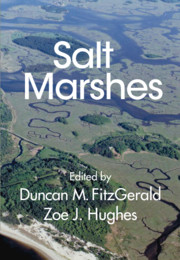Book contents
- Salt Marshes
- Salt Marshes
- Copyright page
- Contents
- Contributors
- Acknowledgments
- 1 State of Salt Marshes
- Part I Marsh Function
- Part II Marsh Dynamics
- Part III Marsh Response to Stress
- 13 Climatic Impacts on Salt Marsh Vegetation
- 14 Impacts of Exotic and Native Species Invading Tidal Marshes
- 15 Marsh Edge Erosion
- 16 Upland Migration of North American Salt Marshes
- 17 Restoration of Tidal Marshes
- 18 Impacts of Climate Change and Sea Level Rise
- Index
- References
14 - Impacts of Exotic and Native Species Invading Tidal Marshes
from Part III - Marsh Response to Stress
Published online by Cambridge University Press: 19 June 2021
- Salt Marshes
- Salt Marshes
- Copyright page
- Contents
- Contributors
- Acknowledgments
- 1 State of Salt Marshes
- Part I Marsh Function
- Part II Marsh Dynamics
- Part III Marsh Response to Stress
- 13 Climatic Impacts on Salt Marsh Vegetation
- 14 Impacts of Exotic and Native Species Invading Tidal Marshes
- 15 Marsh Edge Erosion
- 16 Upland Migration of North American Salt Marshes
- 17 Restoration of Tidal Marshes
- 18 Impacts of Climate Change and Sea Level Rise
- Index
- References
Summary
As humans have spread across the globe, travel and trade have deliberately or inadvertently carried and released animals and plants as well as microbes into new geographies. With human populations concentrated along rivers and coasts, it is not surprising that many exotic species have been released in coastal areas and a few can survive and thrive, especially in habitats similar to those where they evolved. In tidal marshes, organisms experience some of the most extreme physical conditions on earth: temperatures from −20 to 40°C, flooding twice a day but only a few times a month at higher elevations, sediments ranging from oxidized to severely reduced (Eh of +700 to −300 mV), soil salinity from hypersaline (40–90 ppt) to fresh depending on floodwater source and precipitation, and erosive forces from waves, currents, and ice at higher latitudes. Despite these harsh and variable conditions, there are many organisms adapted to tidal marshes, and new introductions and hybrids that can thrive given the opportunity.
- Type
- Chapter
- Information
- Salt MarshesFunction, Dynamics, and Stresses, pp. 367 - 387Publisher: Cambridge University PressPrint publication year: 2021
References
- 2
- Cited by

